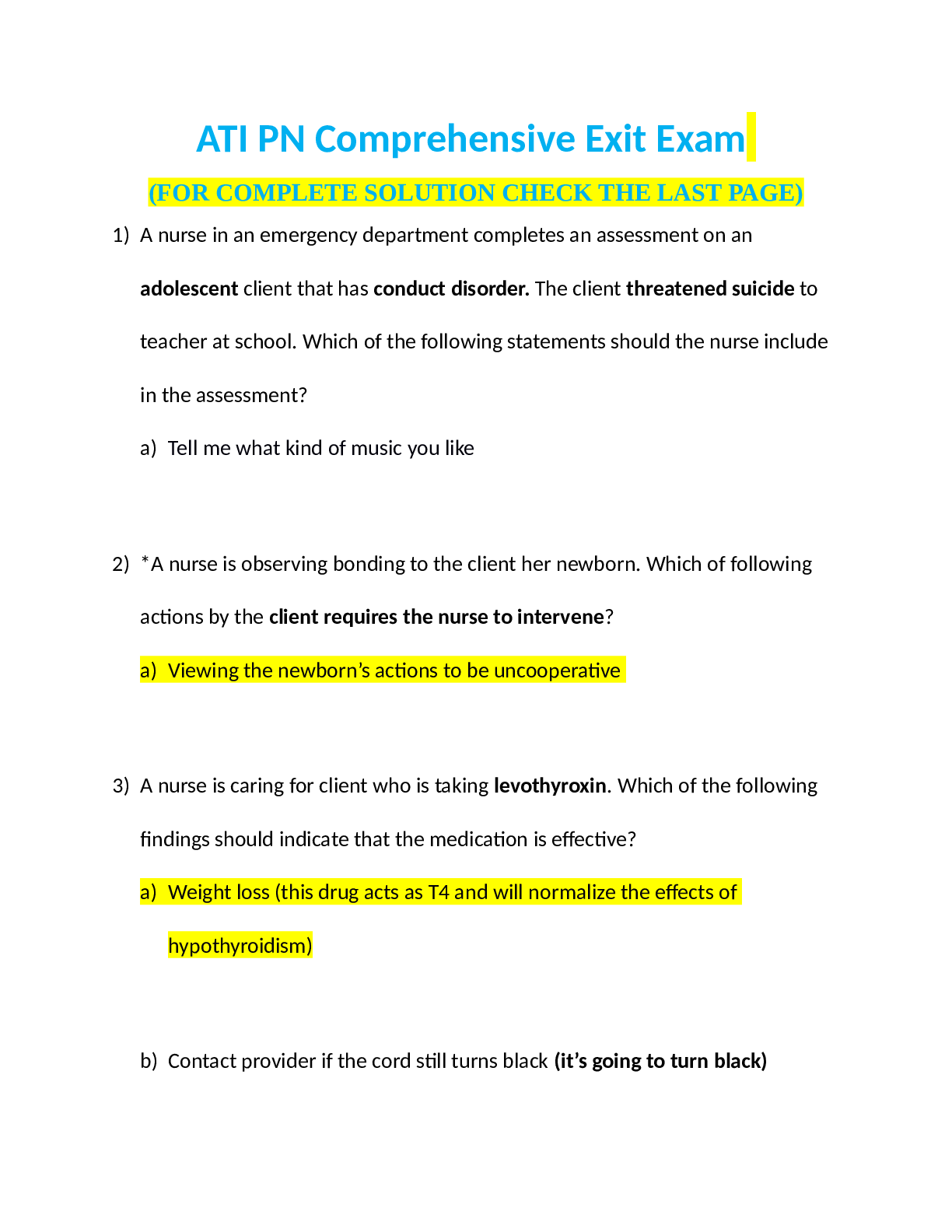*NURSING > QUESTIONS & ANSWERS > Western Governors University - NURSING MS 791: Chapter 19 Hematological, Immunological, and Neoplast (All)
Western Governors University - NURSING MS 791: Chapter 19 Hematological, Immunological, and Neoplastic Disorders. Questions and Answers-with Explantion
Document Content and Description Below
Chapter 19 Hematological, Immunological, and Neoplastic Disor-ders Multiple Choice Identify the choice that best completes the statement or answers the question. ____ 1. The nurse in a pediatri... c clinic is assessing an infant who is 6 months of age. The infant is pale with poor muscle tone. Auscultation reveals tachycardia; in addition, the infant is at the 35th percentile for both height and weight. The physician orders laboratory testing. Which laboratory value does the nurse expect? 1. Erythropoietin level of 1.9 mIU 2. Serum iron 24 mcg/dL 3. Normal RBC index in CBC 4. RBCs small in size and pale ____ 2. A 5-month-old infant is brought to the pediatrician’s office, and the nurse is collecting information from the mother. The mother reports the infant is irritable, eats poorly, and is less active. The nurse identifies tachycardia and a systolic murmur. Which comment by the mother helps the nurse identify the infant’s condition? 1. “I am pleased that he sleeps well at night.” 2. “Up until recently he was a happy baby.” 3. “Formula made him gassy and constipated.” 4. “He has not been what I call really sick.” ____ 3. The nurse is providing care to two children on a pediatric unit. One child is diagnosed with iron-deficiency anemia, and the other has sickle cell disease. Which manifestation does the nurse recognize as being different between the two children? 1. A child with iron deficiency expresses significant pain and discomfort. 2. A child with sickle cell disease experiences varying amounts of joint pain. 3. A child with iron-deficiency anemia experiences normal physical growth. 4. Sickle cell disease is transmitted as a dominant trait from one parent. ____ 4. The nurse is preparing teaching materials for parents with children diagnosed with anemia. Which information will be marked as being specifically for the child diagnosed with sickle cell anemia? 1. Follow a balanced nutritious diet. 2. Encourage drinking as much fluids as possible. 3. Allow low-energy activities and rest periods. 4. Make sure that immunizations are up to date. ____ 5. The nurse is counseling a couple with a 3-year-old toddler diagnosed with hemophilia after experiencing excessive bleeding after a minor injury from a fall. Which teaching is most important for the nurse to provide to the parents? 1. Stressing the need for preventing injury in the environment with supervision, helmet use, and activity restrictions 2. Sharing the availability of resources from the National Hemophilia Foundation publications 3. Preparing them for the possibility of altered family dynamics and how illness may impact financial resources 4. Explaining the importance of allowing the toddler to grow up as normally as possible ____ 6. A 16-year-old adolescent is diagnosed with osteosarcoma and has evidence of metastasis. The nurse calculates the absolute neutrophil count (ANC) daily. The patient asks the nurse to explain the ANC. Which information does the nurse provide? 1. The ANC is a measure of how well treatment is being tolerated by the body. 2. The ANC is total percentage of eosinophils plus the total percentage of basophils divided by the RBC. 3. The ANC provides a daily count of the number of antibodies in the circulating blood. 4. ANC measures of three types of white blood cells. A lower ANC indicates vulnerability to infection. ____ 7. A 12-year-old patient is experiencing pain in the abdomen after receiving chemotherapy. When developing a care plan, for which interventions will the nurse plan for pain management? 1. Application of heating pads to the abdomen 2. Application of cold packs to the chest area 3. Alternative therapy such as aromatherapy 4. Medication for alleviation of abdominal pain ____ 8. An 8-year-old child arrives at the emergency department with abdominal pain and fever. The child has a medical history of leukemia in remission. The nurse receives medical orders for the child. Which order does the nurse recognize as the priority? 1. Draw blood work for a CBC and blood culture. 2. Complete a thorough physical assessment. 3. Set up neutropenic precautions for the child. 4. Prepare the child to be transported to radiology. ____ 9. A 19-year-old college student is being treated for non-metastatic Hodgkin’s lymphoma with chemotherapy. Which recommendation by the nurse was made prior to beginning chemotherapy in order to promote a level of health? 1. Gain weight before treatment to offset weight loss. 2. Consider sperm banking because of expected sterilization. 3. Move in with parents to initiate quarantine protocols. 4. Withdraw from all college courses because of fatigue. ____ 10. The nurse is providing care for a 4-year-old child diagnosed with non-Hodgkin’s lymphoma. The nurse is aware that multiple blood samples are ordered, and the child is scheduled for a lumbar puncture with bone marrow aspiration. Which intervention will the nurse plan to prepare the patient for the testing? 1. Use simple terms and provide a needless syringe for treatment on a stuffed animal. 2. Provide information to the child’s parents and encourage them to explain procedures. 3. Withhold details from the patient until right before testing procedures are performed. 4. Expect that a 4-year-old patient is incapable of understanding or cooperating during procedures. ____ 11. The nurse is providing patient teaching for a school-age patient and parents. Chemotherapy is prescribed for cancer treatment. Before the first dose is administered on an outpatient basis, which teaching is most important for the nurse to provide? 1. Prompt recognition of adverse effects after the therapy. 2. Explain how to immediately initiate protective precautions. 3. Promote nutrition with the preparation of favorite foods. 4. Have icy drinks available to improve oral fluid intake. ____ 12. The nurse in a pediatric oncology unit understands that painful tests and treatments are common for children with cancer. Which interventions does the nurse decide to use to help manage pain for a 6-year-old patient scheduled for diagnostic testing? 1. Avoid too many details that may scare the child. 2. Use language that is age appropriate for the child. 3. Promise the child a toy for cooperating and not crying. 4. Explain why the test is performed without pain medication. ____ 13. A 9-year-old child is being treated for a brain tumor. The patient asks the nurse why there is pain in his head. Which reply by the nurse includes pathophysiology and age-appropriate communication? 1. Explain there is a blockage of blood flow to the brain. 2. State the cancer puts pressure on the neck and causes nerve pain. 3. Explain the growing brain tumor presses on some nerves in the head. 4. State the medications being given are causing the headache. ____ 14. The parents of a 4-year-old toddler bring the child to the pediatrician because a lump is found in the toddler’s waist area. Diagnostic testing verifies the toddler has a Wilms’ tumor on the right kidney. The toddler is to be sent home until scheduled surgery. Which teaching is essential for the parents regarding preoperative care? 1. Promote hydration by increasing fluid intake. 2. Maintain a side position with pillows for sleeping. 3. Avoid palpating the tumor and pushing or lifting in the area. 4. Provide information about postoperative care. Multiple Response Identify one or more choices that best complete the statement or answer the question. ____ 15. During the treatment of a preschool child for anemia, laboratory tests reveal the child is also positive for lead poisoning. The child is currently living in an older home being renovated by the parents. Which teaching does the nurse provide to the parents? Select all that apply. 1. The possibility of removing the child from the environment 2. Methods to remove paint chips or dust from the environment 3. Details about behavior changes indicating additional exposure 4. Recommendation of foods that will decrease absorption of lead 5. The need for a child development specialist to evaluate the child ____ 16. The nurse is providing care for an adolescent female who just gave birth to a neonate. The mother tests positive for HIV; however, the mother did not receive prenatal care. Based on the nurse’s understanding about HIV/AIDS, which interventions does the nurse expect? Select all that apply. 1. Placement of the neonate in foster care because of deficient parenteral care 2. Performance of HIV polymerase chain reaction (PCR) test on the neonate 3. Recommended virological diagnostic testing for the neonate 4. Immediate immunization of the neonate against common childhood illnesses 5. Nutritional management that includes high-calorie, nutrient-dense foods ____ 17. The nurse case manager is providing care and support to a mother with AIDS who has an infant who also tests positive for the condition. Which statement by the mother indicates to the nurse that additional teaching is needed? Select all that apply. 1. “I wish I could control the baby’s pain without so much medication.” 2. “I am so looking forward to the time when the baby is no longer infectious.” 3. “I absolutely do not want the day-care staff to know about the baby’s condition.” 4. “If I am to become a better mother, I need to work on my self-esteem and self-value.” 5. “I keep hoping every day that a cure for my baby and me can be found.” ____ 18. A toddler who is 2 years of age is cared for by a grandmother because of the death of the toddler’s mother from AIDS. A critical nursing intervention is for the nurse to provide home-care instructions. Which points should the nurse emphasize? Select all that apply. 1. Hand hygiene precautions during hospitalization 2. Importance of keeping up to date with all childhood immunizations 3. Proper nutrition for a toddler diagnosed with the disease 4. Monitoring playmates in order to avoid childhood viruses 5. Prevention of bacterial infections as the treatment focus ____ 19. A pediatric patient has acute myelocytic leukemia, and patient and family are considering treatment options aimed at long-term success. Which contemplated treatment involves using the patient’s stem cells collected before radiation of cancerous bone marrow? Select all that apply. 1. Allogenic 2. Autologous 3. Peripheral blood stem cells (PBSC) 4. Umbilical cord stem cells 5. Platelet transfusion ____ 20. An adolescent 16 years of age and the parents and health-care team agree that the patient is to undergo HSCT. Which specific nursing interventions will be included for the care of this patient? Select all that apply. 1. Sterility of the central line must be maintained. 2. High-dose chemotherapy and/or total body irradiation is administered. 3. IV for the administration of stem cells is established and maintained. 4. Fluid loss from urine, vomiting, and/or diarrhea is closely monitored. 5. Anti-T-cell immunotoxins are administered immediately after the transfusion. [Show More]
Last updated: 1 year ago
Preview 1 out of 16 pages

Reviews( 0 )
Document information
Connected school, study & course
About the document
Uploaded On
Jan 15, 2021
Number of pages
16
Written in
Additional information
This document has been written for:
Uploaded
Jan 15, 2021
Downloads
0
Views
52













.png)
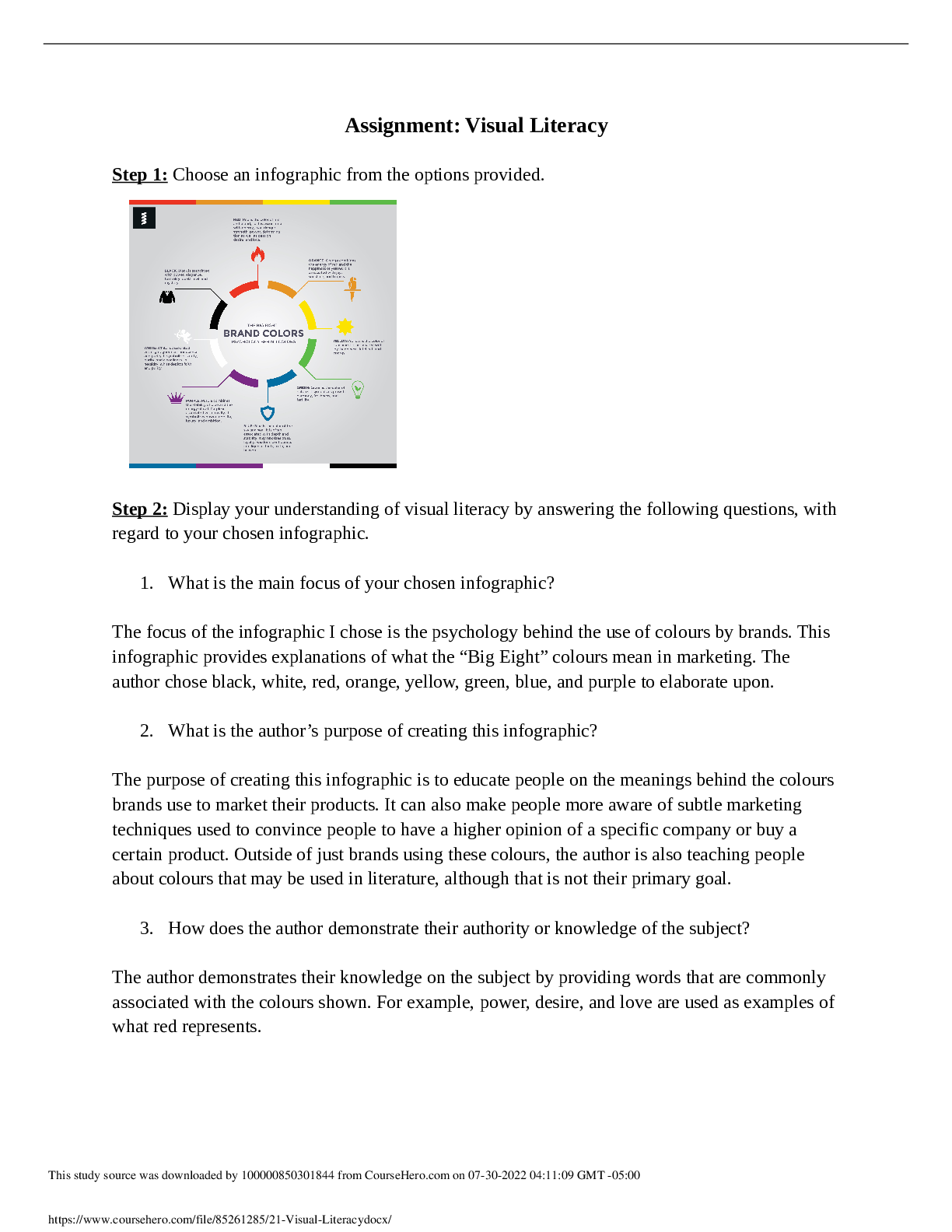

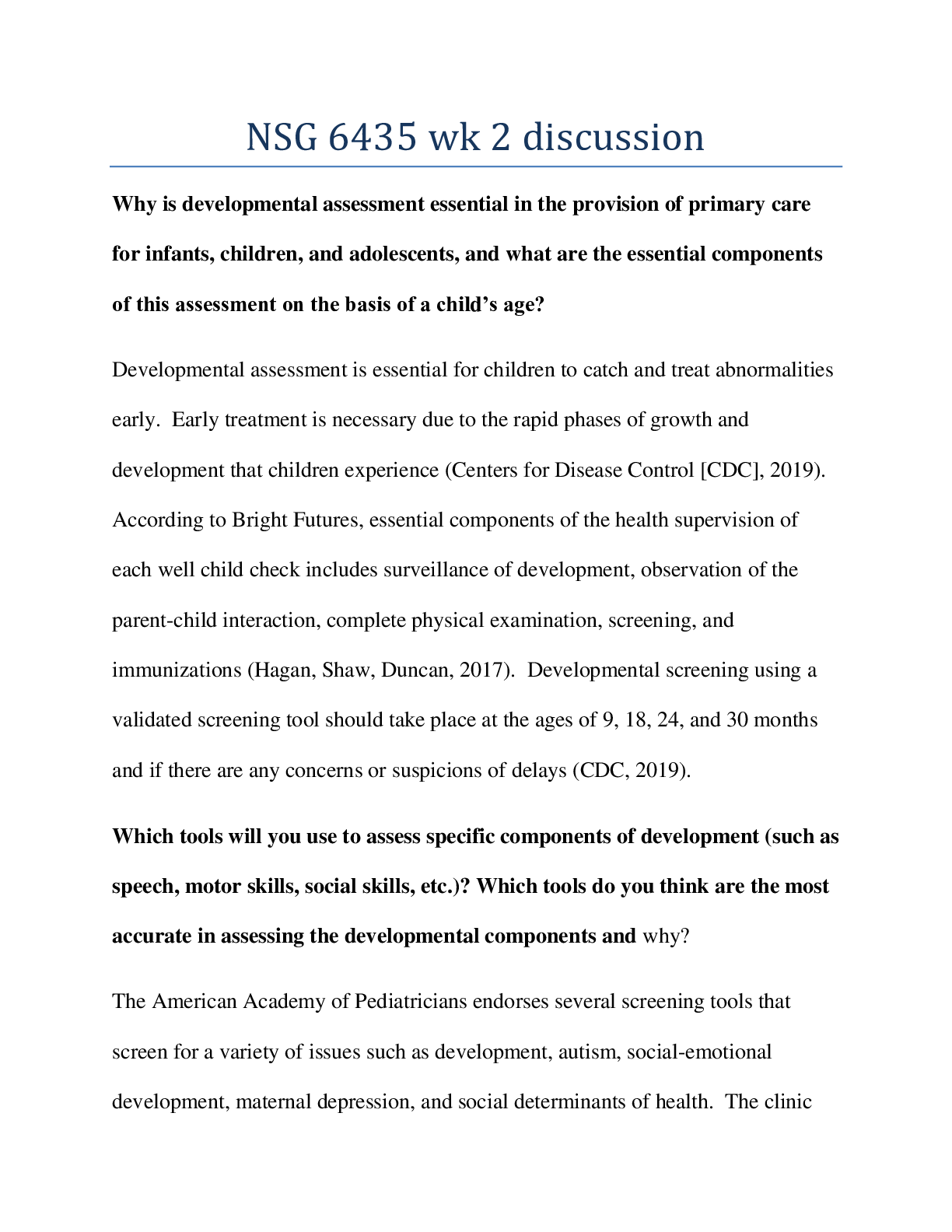
 Correct Study Guide, Download to Score A.png)
 Correct Study Guide, Download to Score A.png)
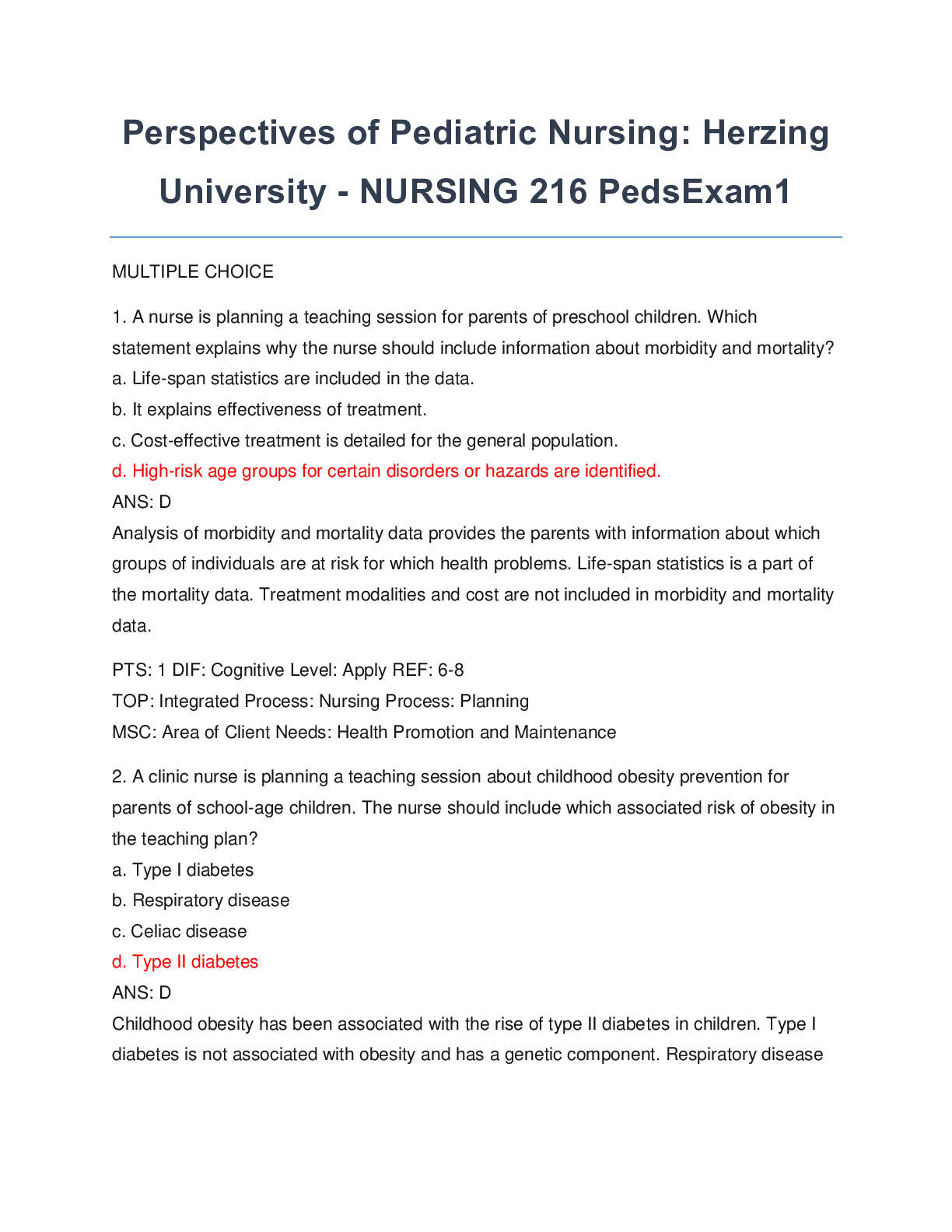
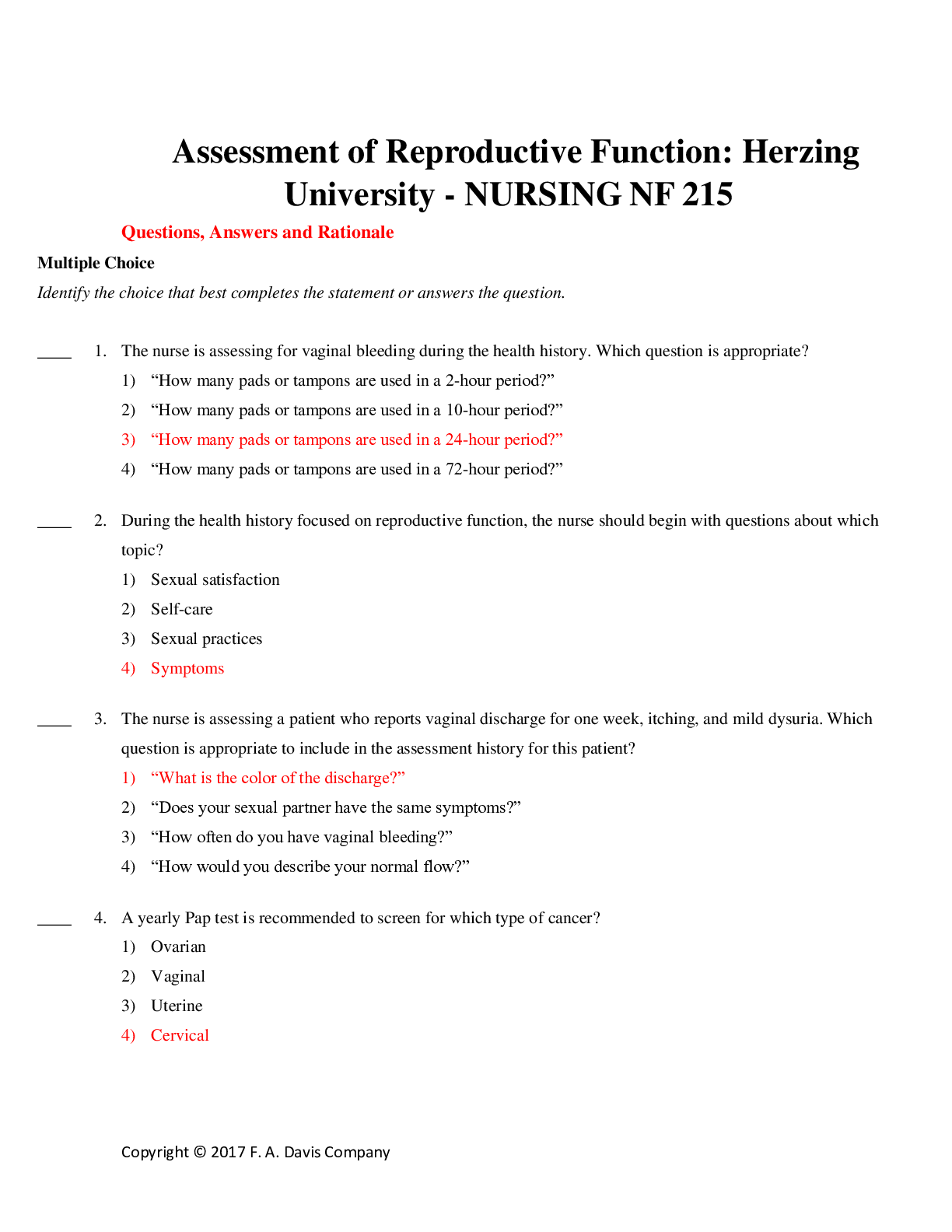

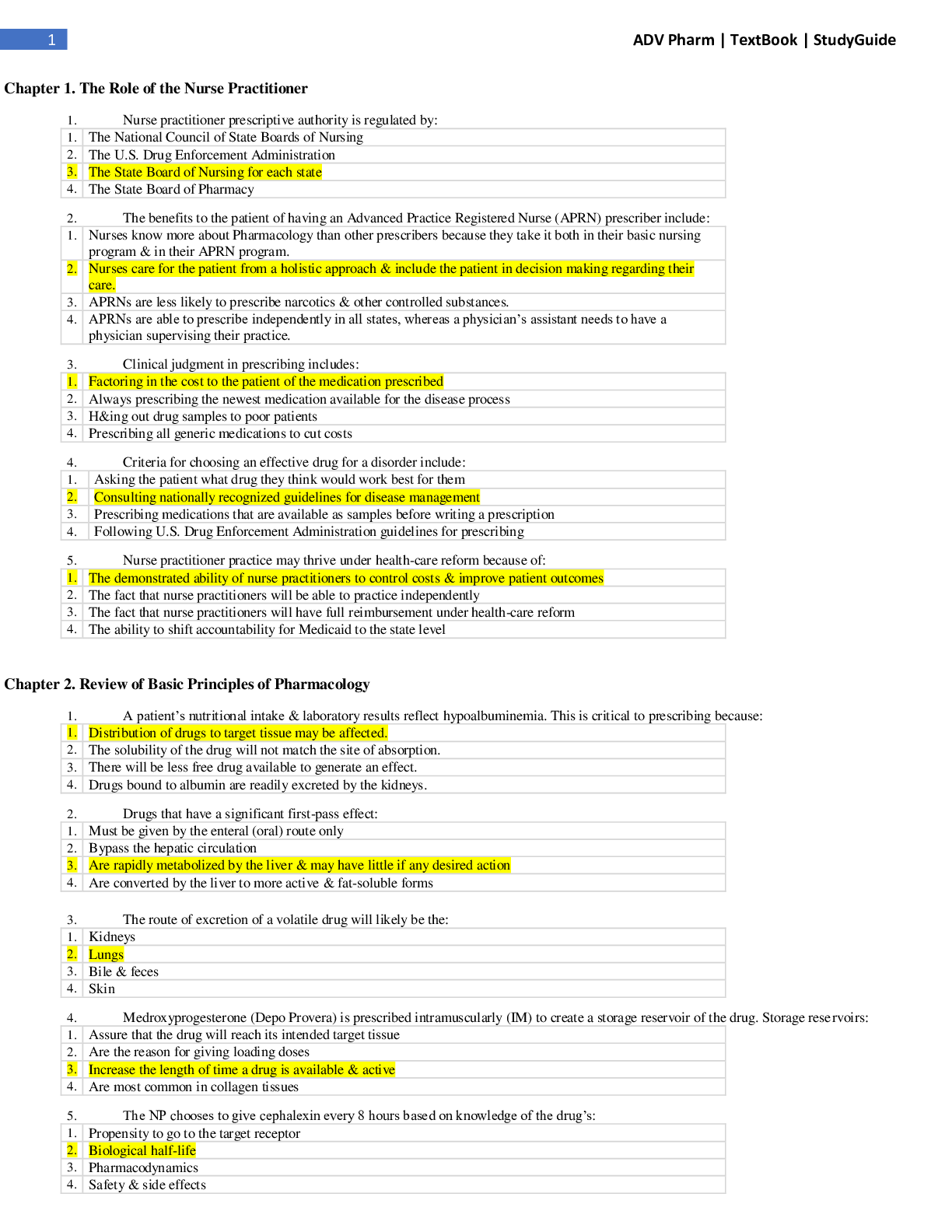
 Correct Study Guide, Download to Score A.png)
.png)
 Correct Study Guide, Download to Score A.png)
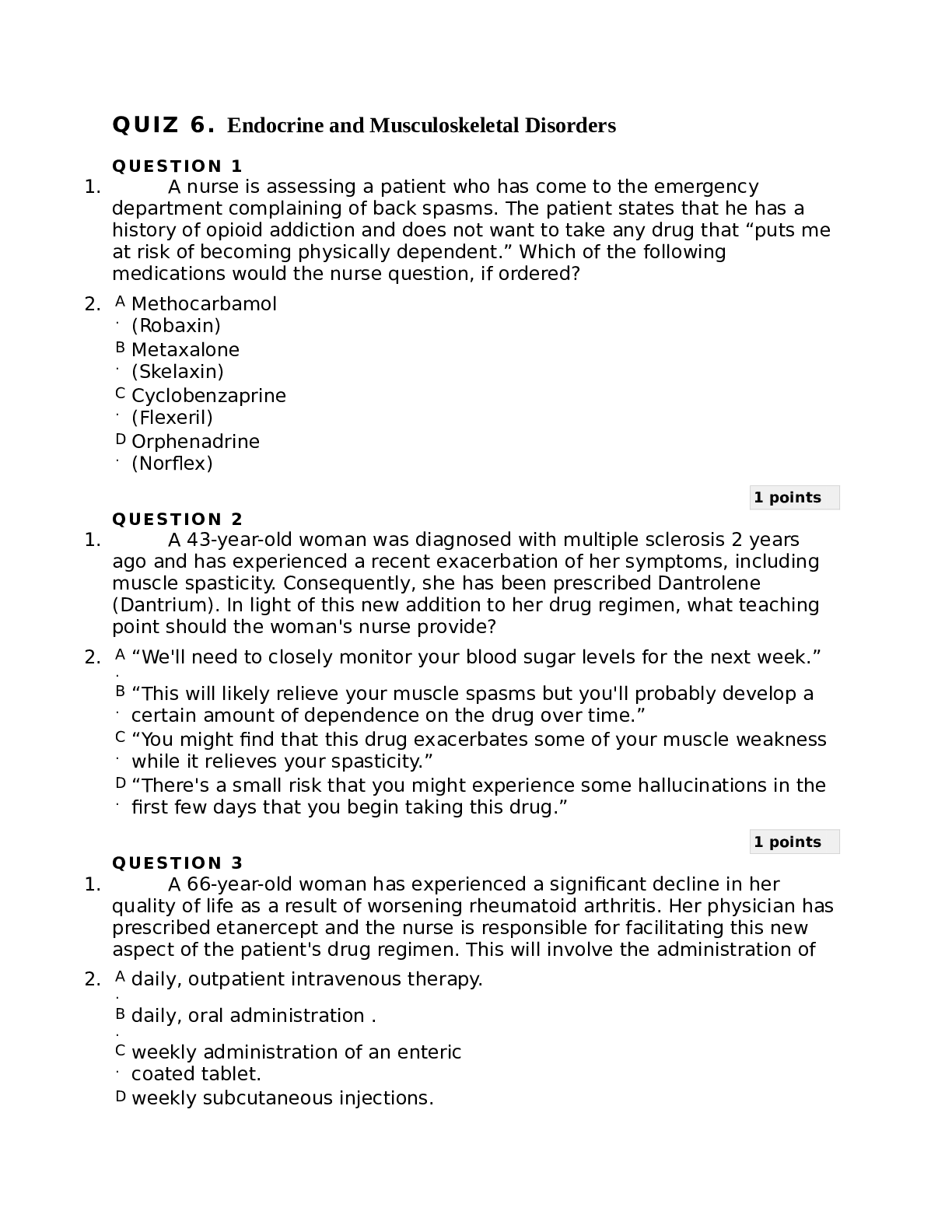
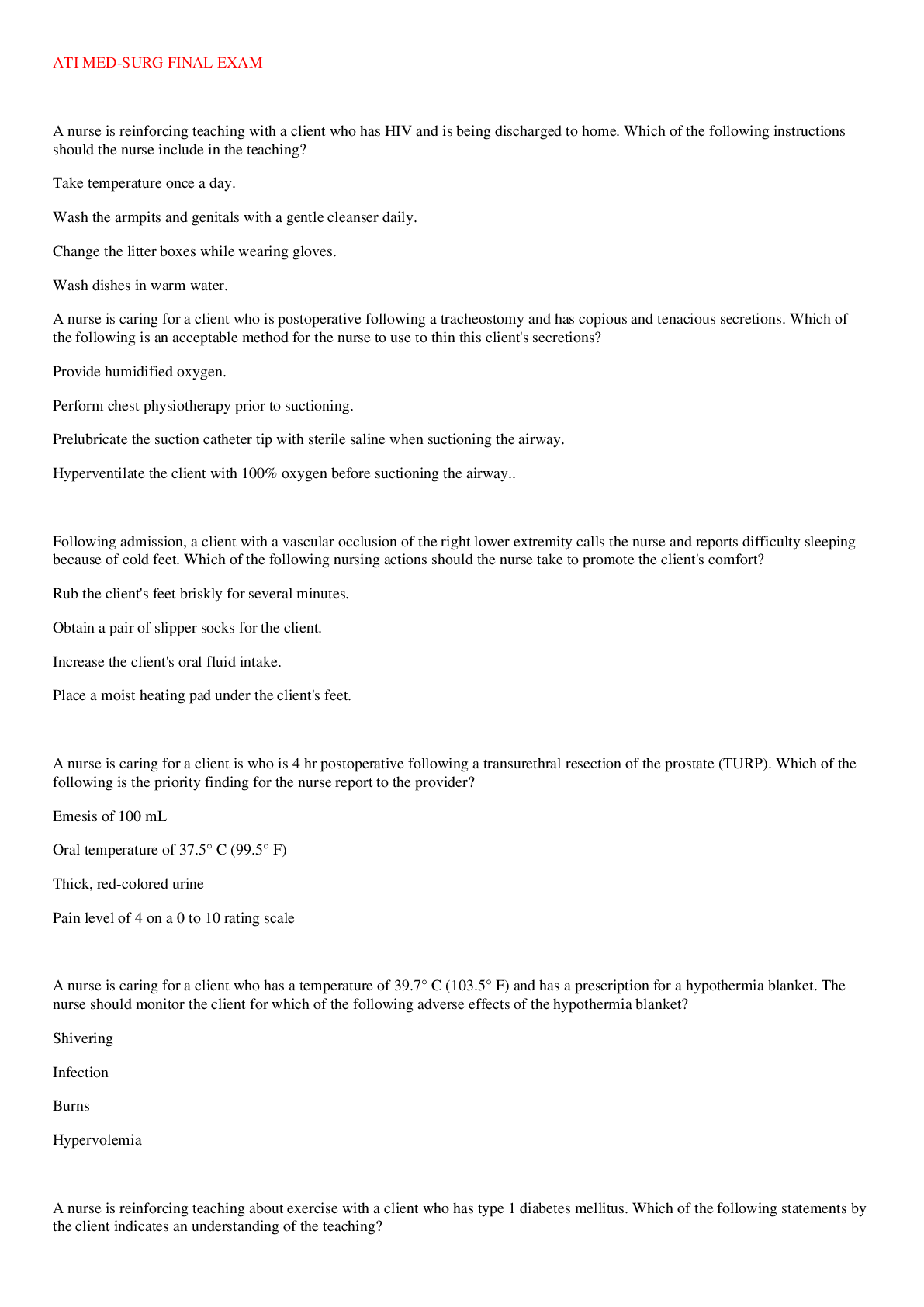

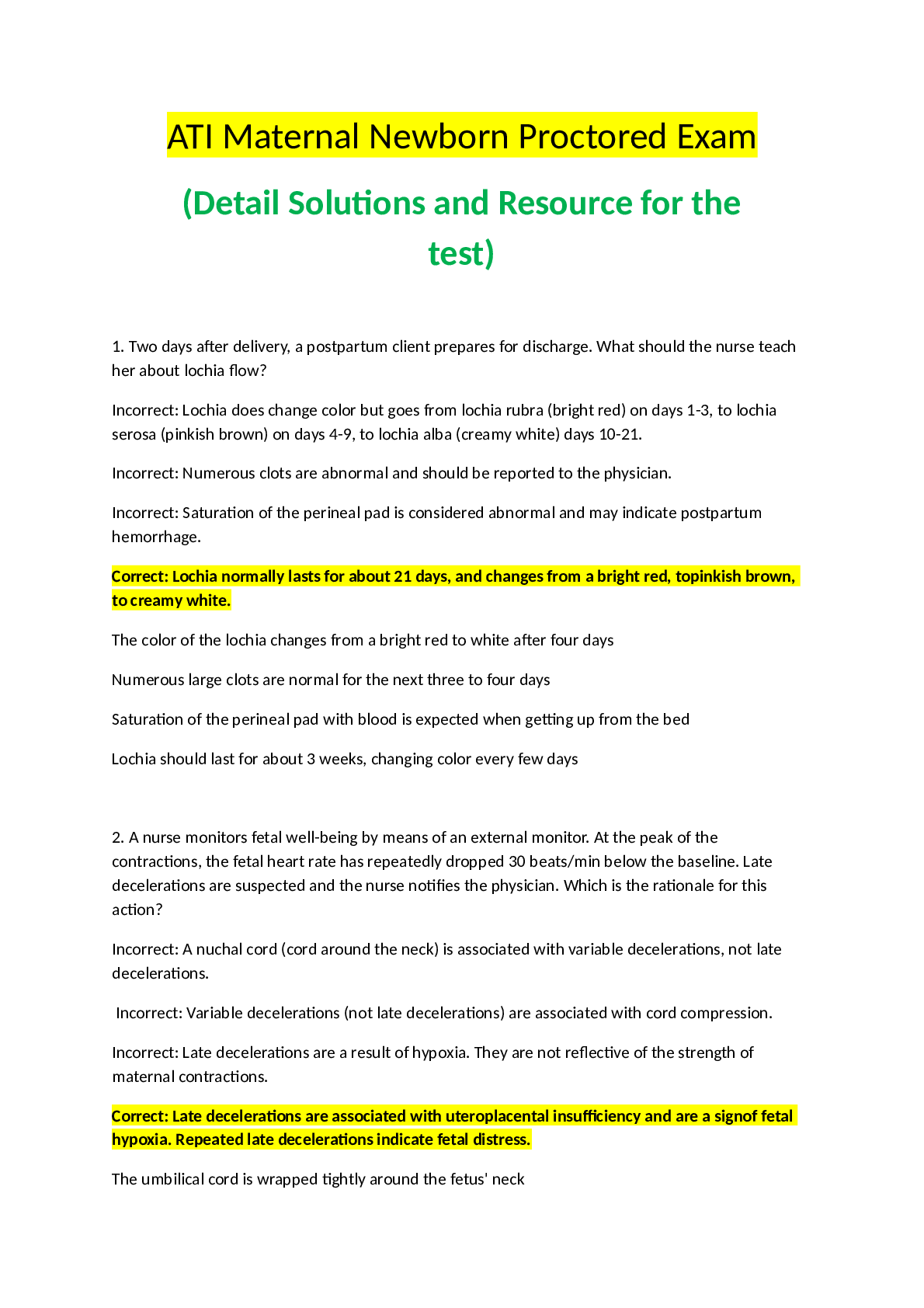
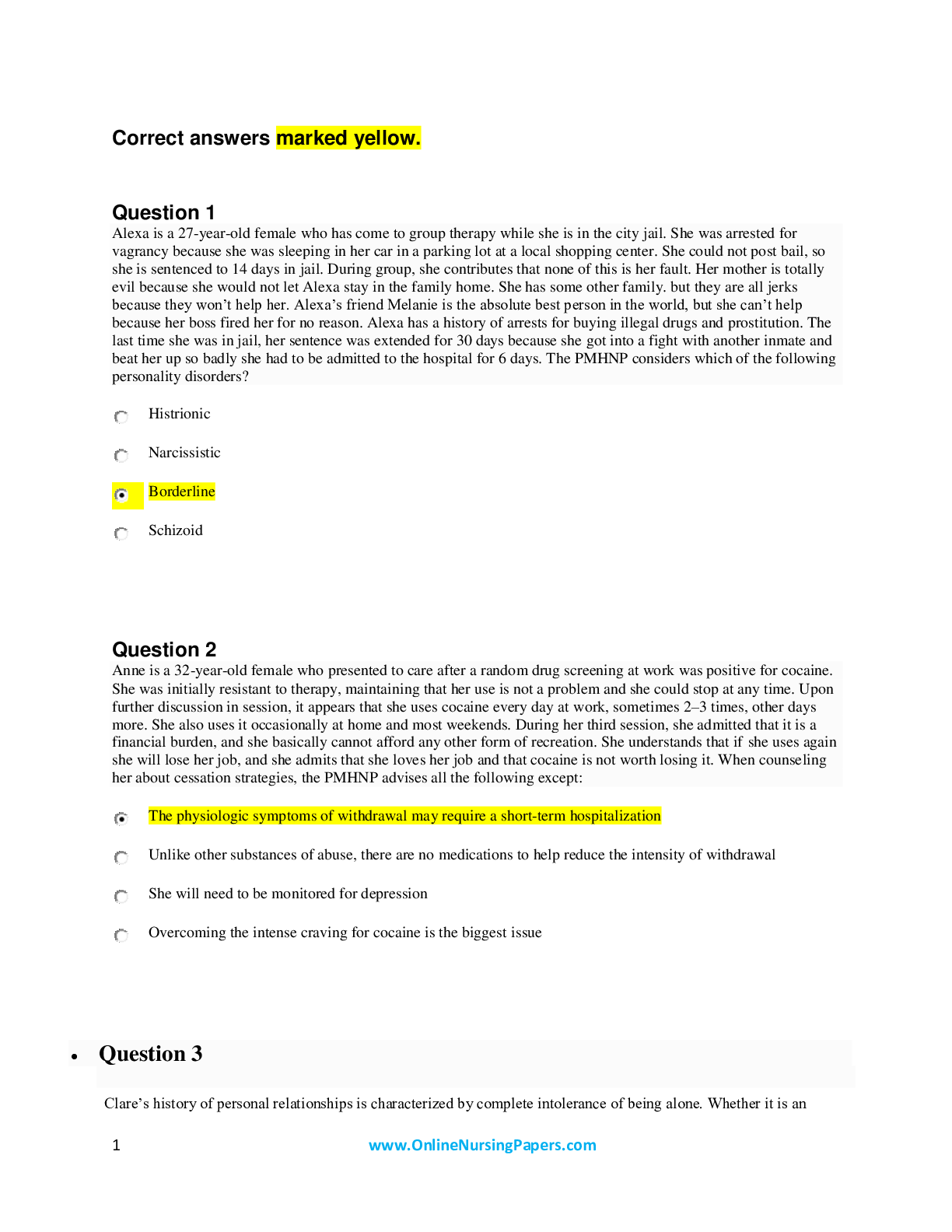
 Correct Study Guide, Download to Score A.png)
 Correct Study Guide, Download to Score A.png)

